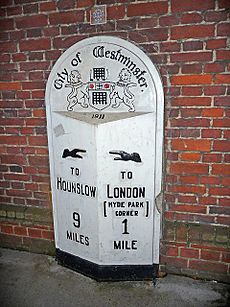Mile facts for kids

A mile is a unit of length, which is a way to measure how long something is. While there are different types of miles, when people just say "mile," they usually mean the statute mile.
Contents
What is a Statute Mile?
When you hear the word "mile" in countries like the U.S. or the U.K., it almost always refers to the statute mile. This is the most common type of mile.
Here's how a statute mile compares to other units of length:
| Unit | Length |
|---|---|
| 1 statute mile | 5,280 feet |
| 1 statute mile | 1,760 yards |
| 1 statute mile | 8 furlongs |
| 1 statute mile | About 1.6 kilometres |
What is a Nautical Mile?
The nautical mile is a special type of mile used mainly for travel over water or in the air. Think of ships sailing the ocean or planes flying high above.
The idea for the nautical mile came from how we measure distances on Earth. It was first defined as one minute of arc along a line of longitude on our planet. Imagine drawing lines from the North Pole to the South Pole; one minute of arc is a tiny slice of that line.
Today, the nautical mile has a set definition:
- 1 nautical mile = 1,852 metres
- This is about 6,076 feet
- It's also about 1.15 statute miles
When a ship travels one nautical mile in one hour, its speed is called one knot. So, knots are used to measure how fast ships and planes are moving.
What is a Roman Mile?
The idea of the mile actually started with the Romans. The word "mile" comes from the Latin phrase mille passus. This means "one thousand paces." A pace was the distance a person covered with two steps (one with the left foot, then one with the right).
Here's how a Roman mile measured up:
- 1 Roman mile = 1,000 Roman paces
- This was about 1,479 metres
- It was also about 4,852 feet
Other Types of Miles
Throughout history, different places have used their own versions of the mile. For example, in countries like Norway and Sweden, a "mil" is a unit of length that is equal to 10 kilometres. This shows that the word "mile" can mean different things depending on where you are and what time period you're looking at!
Images for kids
-
The remains of the Golden Milestone, which was like the "zero-mile marker" for all Roman roads, found in the Roman Forum.
-
Edinburgh's "Royal Mile" runs from the castle to Holyrood Abbey. It's roughly one Scots mile long.
-
This is a scalebar from a map made in the 1500s by Mercator. It shows distances in "Hours walking or common Flemish miles," and includes three different sizes of Flemish miles.
-
This image from an 1848 German textbook shows various historic miles and leagues. Their lengths are given in feet, metres, and parts of a degree of meridian.
See also
 In Spanish: Milla para niños
In Spanish: Milla para niños





